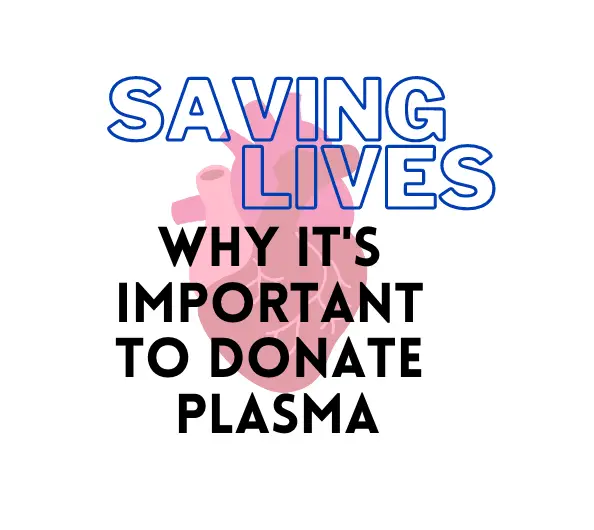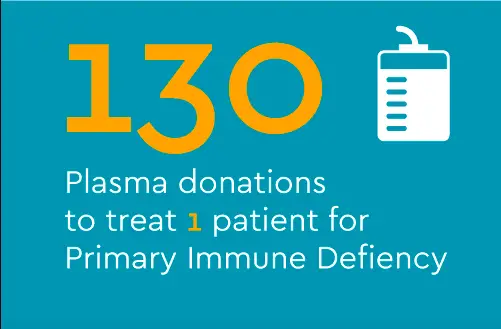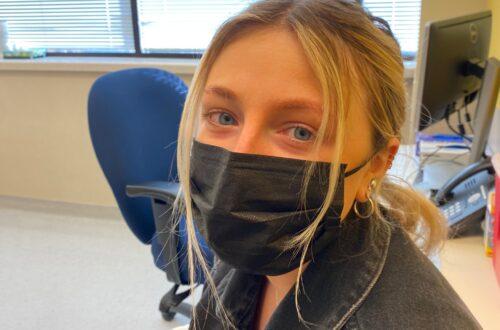
Saving Lives: Why it’s important to donate plasma
Table of Contents
In celebration of World PI Week, I thought I would talk about something that is very important to PI patients, particularly those who utilize immunoglobulin replacement therapy (Ig). In order for us to receive treatment, we have to use donated plasma. Plasma has antibodies, which is what patients with PI lack to fight off illnesses. Every time we get a plasma infusion, we are receiving helpful antibodies that give us some of our life back! Without plasma, my quality of life would be so poor. I am always appreciative to those who donate plasma.
If you are interested in donating plasma and want to know more about it, this one is for you!
What happens when you donate plasma?
This is a brief introduction and summary of plasma donation. Essentially, the donor’s blood is not taken in this case, only the plasma. Blood is drawn from the donor’s body, put into a machine, and then the machine takes the plasma. The red blood cells and platelets are returned into the donor’s body with saline. You can read more about this here.
I was pretty shocked to find out that blood is actually inserted back into the patients body! Later in this article, I will provide a first-hand overview from someone who has donated plasma!
Why should I donate plasma?
First of all, you get paid for it! I had a few friends in college, including my boyfriend, who donated plasma and made a little extra cash. It varies from place to place, but I have heard of people making about $800 a month.
Secondly, you are saving lives every single time you donate. This greatly helps patients like me to be able to create immunity against illness and live a normal life. I am so grateful for those who donate!
Plasma helps patients treat multiple diseases including hemophilia, Kawasaki disease, Von Willebrand disease, and more.
While the idea of donating might be intimidating or scary, you know that your plasma is going to a great place and that you are saving lives.

How to donate plasma
There are several different places to donate plasma, so you will have to do a little research to see what plasma donation centers are near you. When I lived in Fort Collins, I knew a few people who donated at CSL Plasma. If you visit their website, you can see if there is a center near you. There seem to be a good amount of locations!
You also have to see if you qualify to donate. Here are some main qualifications:

You can read a full list of qualifications here.
Some other places to donate include: Octapharma Plasma, Grifols Plasma, BioLife Plasma.
What is donating plasma like?
Since I am the one that needs to plasma, I have never donated, but I have spoken first-hand with someone who has, my boyfriend, Maxx. Here are his thought on what donating plasma is like:
“I went to CSL Plasma. The staff is always friendly. People are there for a few different reasons, whether it’s money, inspired by a loved one, or something else.
You have to go through a physical and health screening to make sure that you are able to donate plasma. They prick your finger to check how much water concentration is in your blood. If you are good to go, you go wait in line!
When you first get in your chair, there are definitely some butterflies. I was nervous the first time. From there, they give you an overview. After that, the needle goes in, and it begins!
What is so interesting is that there are different intervals of the process. Blood is moving out of your body and then back into your body. You have to compress or relax based on what is happening.
The more hydrated you are, the faster the process will be. I averaged about 40 minutes. Some people take 30, others take over an hour.
After it’s over, you are free to go!”

He also provided some tips for before donating:
“Drink as much water as you possibly can!! For at minimum, the 24 hours before your appointment. I would pump fluids 48 hours before. I would also recommend a light snack before you get in the chair. (Pro Tip: Use the restroom before you get to the clinic).”
Thank you, Maxx, for sharing your experience!
It’s definitely helpful to hear from someone who has done it before, especially to help calm the nerves of first-timers.
Plasma saves lives!
According to Prometic Plasma Resources, it takes 130 plasma donations to treat 1 patient with Primary Immunodeficiency! That’s a lot of plasma, which means every single donation counts.

The PI community couldn’t function without donors. Every day, people’s lives are transformed by this treatment. Especially since there is no cure as of right now. I know that I will probably be using plasma for the rest of my life, and I am only 23 years old! That is a LOT of plasma donations. I couldn’t do it without all of the people who sacrifice their time and comfort to donate those healthy antibodies.
If you want to donate plasma, it’s an amazing thing to do!
Other articles to check out
Aubrey Grace – Are Plasma Treatments Painful?
Aubrey Grace – Plasma Treatment: The Rundown
Newswise – Donating Your Plasma Saves the Lives of Those with Primary Immunodeficiency






6 Comments
hailee
such an important post! thank you for sharing!
MyMomPlans
An informative and important post. Thank you for sharing 🙂
Amanda
Awe you are still so young! I’m glad you have supportive people, including your boyfriend, who is also willing to do things that can benefit people in situations like yours. Great informative post.
Debbie
Thank you for highlighting what donating plasma does and the process. Very helpful information!
Kathy
I didn’t know this was how my immunoglobulin treatment was collected. Thanks for sharing this info.
Tracy McHugh
Thanks for sharing this! I’ve donated blood quite a few times but only recently heard about donating plasma from a news segment a few months ago.